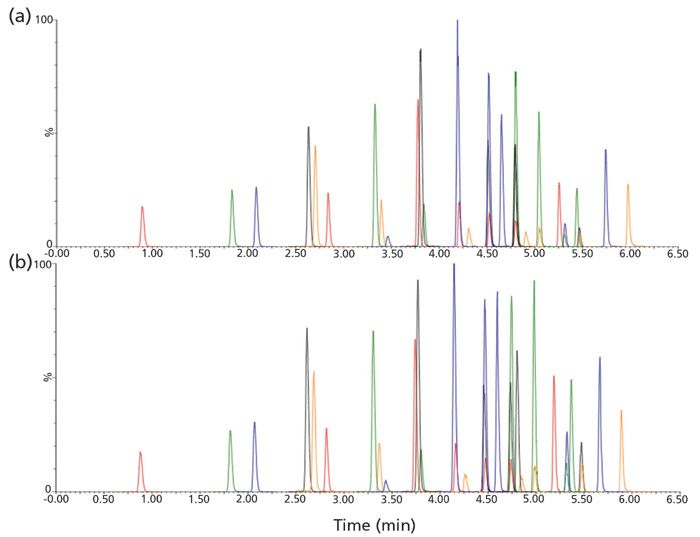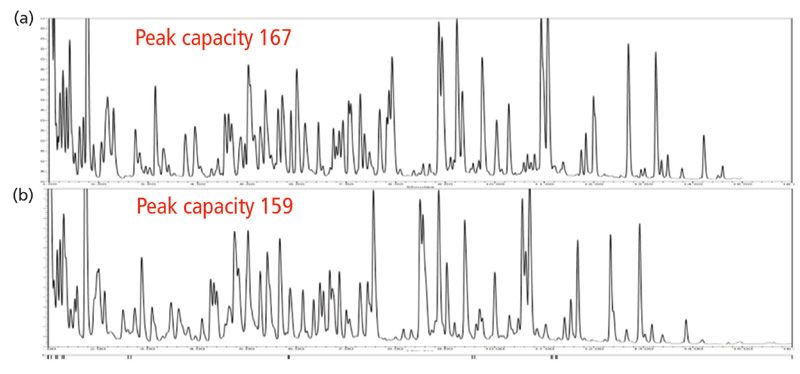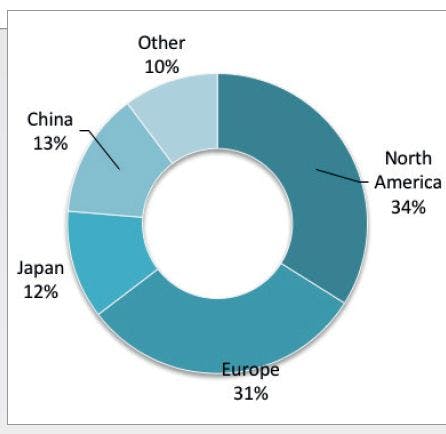When Do We Need Sub-2-μm Superficially Porous Particles for Liquid Chromatography Separations?
LCGC North America
Many manufacturers now offer columns using superficially porous particles that are 2-µm and smaller. When should you use them?
The use of superficially porous particles (SPPs) for modern high performance liquid chromatography (HPLC) is now very common. Initially, SPPs rose as an alternative to sub-2-µm fully porous particles (FPPs). In recent years, many column manufacturers have developed 2-µm and smaller SPP-based products. This article investigates the practical utility of these smaller SPP designs.
The introduction of modern superficially porous particles (SPPs) by Advanced Materials Development in 2006 revolutionized high performance liquid chromatography (HPLC). Interest in these particles, characterized by a solid core and a porous outer layer, stemmed from the very high efficiency they produce at modest back pressures (1). During the time of SPP emergence, efforts to improve efficiency focused on decreasing the size of packed particles. The term ultrahigh-pressure liquid chromatography, or UHPLC, was coined by Jorgenson in 1997, and was based on studies of nanobore columns packed with 1–1.5 µm particles (2). In 2004, Waters introduced the first commercial liquid chromatography system capable of operating at pressures as high as 1000 bar. Together with the availability of columns packed with sub-2-µm particles, the age of UHPLC was born. The small sub-2-µm particle size resulted in high system back pressures that required instrumentation capable of operating under such conditions. The SPP design proved to be a viable alternative to smaller fully porous particles (FPPs), because columns packed with sub-3-µm SPP materials provided similar efficiencies to sub-2-µm FPP columns at back pressures that were attainable on standard HPLC systems (3).
Since the initial rise of SPP columns with particle sizes around 2.7 µm, many manufacturers have developed stationary phases using smaller and larger particles, as well as particles with various pore structures. In 2014, Fekete and coauthors predicted that one future trend for UHPLC would be the incorporation of sub-2-µm SPP columns (4). The authors note that, because of significant improvements in eddy diffusion, moderate decrease in longitudinal diffusion, and some improvement in mass transfer resistance, SPPs offer a 30–50% increase in efficiency over same particle size FPPs, regardless of the particle size. Efficiency gains for smaller SPPs should thus trend similarly with what has been observed for FPPs. It was also noted that only two sub-2-µm columns were commercially available at that time.
In another paper, Fekete and Guillarme evaluated a 1.3-µm SPP phase, noting kinetic advantages over fully porous packed columns. Efficiencies greater than 500,000 plates/m were observed as compared to 300,000 typically generated by a well-packed sub-2-µm FPP column. The authors noted that the performance of the column was limited by the current instrumentation. Lower extracolumn variance and higher pressure limits for both the column and the instrument were noted as potential improvements (5).
DeStefano and coauthors noted that the advantages of smaller SPPs include higher efficiency, improved detection sensitivity, less mobile-phase consumption per analysis, higher peak capacity, and the perception of state-of-the-art technology. The authors also noted the following disadvantages:
- Smaller particles require higher-pressure instruments, with minimal extracolumn volume, and small internal diameter connection tubing (plugs, increased back pressure).
- High-pressure operation may equal more frequent instrument repair.
- Smaller column frits may clog more easily than larger frits used for larger particle size columns.
- Columns may not exhibit expected efficiencies because smaller particles are more difficult to pack.
The authors noted that smaller particles do provide utility for some applications, but the efficiency advantage often does not overcome the disadvantages (6).
The availability of commercial 2-µm and sub-2-µm columns mid-year 2015 was still limited. Advanced Material Technologies and Supelco had introduced 2-µm column lines with several surface modifications. Phenomenex offered both a 1.3-µm (C18) and a 1.7-µm version of the Kinetex brand. Thermo Fisher Scientific commercialized a 1.4-µm C18 phase, and Waters launched a 1.6-µm platform with bare silica and C18 surface chemistries (7). In a 2016 review, no new providers entered into the 2-µm and sub-2-µm SPP market; however, two additional stationary phases, Kinetex EVO-C18 and HALO Peptide ES C18 (Mac-Mod), were made available (8). In 2017, Agilent introduced a number of chemistries on 1.9-µm SPPs, including bare silica for HILIC. ChromaNik introduced SunShell in a 2-µm format, Waters introduced 1.6-µm Cortecs with additional chemistries, and Phenomenex introduced a 1.7-µm SPP column intended for characterization of RNA and DNA (9). It is clear from this list that the trend toward smaller SPPs has indeed continued.
There have been many publications in recent years about studies employing SPP phases of all sizes for applications in a variety of disciplines. Within the literature scanned for this installment of "Column Watch," no "applied" publications could be found that compared sub-3-µm SPP phases to sub-2-µm SPP phases explicitly. In a systematic evaluation of commercially available UHPLC columns for drug metabolite profiling, Dubbelman and coauthors found 1.3-µm and 1.7-µm SPPs to provide highly efficient separations. However, the system pressure experienced using the 1.3-µm particles was noted as an issue when higher flow rates were employed in an attempt to shorten run times (10).

Figure 1: Comparison of 1.8- and 2.7-µm superficially porous particle columns for the separation of 34 perfluorinated compounds. Columns: (a) Raptor C18, 1.8 µm, (b) Raptor C18, 2.7 µm; column dimensions: 50 mm × 2.1 mm; mobile-phase A: 5 mM ammonium acetate in water; mobile-phase B: methanol; gradient: 20-95% B in 6 min; flow rate: 0.4 mL/min; column temperature: 40 °C; detection: mass spectrometry.
So the question still remains, "Does one need to use 2-µm or sub-2-µm SPP phases, or do sub-3-µm SPP phases suffice?" The answer depends on the analysis at hand. For example, Figure 1 shows a reasonably complex separation of perfluorinated compounds (PFCs) on both a 1.8-µm SPP and a 2.7-µm SPP. With very little difference observed in terms of sensitivity, resolution, or peak shape, it would be difficult to justify running this method at the higher back pressure using the 1.8-µm phase. Figure 2 shows a comparison of 1.8-µm and a 2.7-µm SPP–based biphenyl columns performing a separation of artificial sweeteners. In this case, the 1.8-µm phase shows additional resolution over the 2.7-µm phase. The more complex the sample, the higher the probability that higher efficiency will be needed. Figure 3 provides a comparison of a bovine serum albumin (BSA) tryptic digest run on both a 1.8-µm and a 2.7-µm SPP-based C18 column. As indicated by the higher peak capacity, using the smaller SPP column, the increased efficiency may become more important for such complex samples.

Figure 2: Comparison of 1.8- and 2.7-µm superficially porous particle columns for the separation of 11 artificial sweeteners. Columns: (a) Raptor Biphenyl, 1.8 µm, (b) Raptor Biphenyl, 2.7 µm; column dimensions: 50 mm × 2.1 mm; mobile-phase A: 0.1% formic acid in water; mobile-phase B: 0.1% formic acid in acetonitrile; gradient: 5-55% B in 3 min; flow rate: 0.3 mL/min; column temperature: 40 °C; detection: mass spectrometry.
As with many so many questions when it comes to chromatography, the answer to whether one needs to enter into the 2-µm and sub-2-µm SPP realm is "It depends". It appears that, as the complexity of the separation increases, the probability of needing the extra efficiency of a smaller SPP increases. In many cases, however, closely eluted compounds, even in a two- or three-analyte separation, may require added efficiency and thus smaller SPP-based phases. In practice, the use of sub-3-µm SPP columns is typically a suitable compromise for method development. Adjustment to smaller (or larger) particle sizes during method optimization may provide a more suitable final method.

Figure 3: Comparison of 1.8- and 2.7-µm superficially porous particle columns for the separation of trypsin-digested BSA. Columns: (a) Raptor ARC18, 1.8 µm, (b) Raptor ARC18, 2.7 µm; column dimensions 100 mm × 2.1 mm; mobile-phase A: 0.1% trifluoroacetic acid in water; mobile-phase B: 0.1% trifluoroacetic acid in acetonitrile; gradient: 10-20% B in 6 min, 20-40% B at 15 min; flow rate: 0.3 mL/min; column temperature: 60 °C; detection: mass spectrometry.
References
(1) J.J. Kirkland, S.A. Schuster, W.L. Johnson, and B.E. Boyes, J. Pharm. Anal. 3, 303–312 (2013).
(2) J.E. MacNair, K.C. Lewis, and J.W. Jorgenson, Anal. Chem. 69, 983–989 (1997).
(3) V. González-Ruiz, A.I. Olives, and M.A. Martín, TrAC - Trends in Analytical Chemistry 64, 17–28 (2015).
(4) S. Fekete, J. Schappler, J.L. Veuthey, and D. Guillarme, TrAC - Trends in Analytical Chemistry 63, 2–13 (2014).
(5) S. Fekete and D. Guillarme, J. Chromatogr. A 1308, 104–113 (2013).
(6) J.J. DeStefano, B.E. Boyes, S.A. Schuster, W.L. Miles, and J.J. Kirkland, J. Chromatogr. A 1368, 163–172 (2014).
(7) D.S. Bell and R.E. Majors, LCGC North Am. 33(6), 386–395 (2015).
(8) D.S. Bell, LCGC North Am. 34(4), 242–252 (2016).
(9) D.S. Bell, LCGC North Am. 35(4), 226–239 (2017).
(10) A.C. Dubbelman et al., J. Chromatogr. A 1374, 122–133 (2014).
ABOUT THE AUTHOR
Landon Wiest

Landon Wiest is an LC Applications Scientist at Restek. Over the last five years, Landon has worked developing innovative LC Products and now focuses his attention on LC applications in the food safety area. He completed his PhD in analytical chemistry at Brigham Young University (Provo, UT) where he received instruction from Milton Lee and studied the viability of diamond, and other carbon-based materials, as stationary phase supports for liquid chromatography under Professor Matthew Linford. Landon's primary focuses have been on developing novel chromatography phases on various supports and finding new applications for them that can increase the capabilities of the chromatography community. He has presented his research at numerous international conferences and had it published in multiple peer-reviewed journals. He has also been awarded patents for his inventions.
Shun-Hsin Laing

Shun-Hsin Laing is a Senior LC Applications Scientist at Restek. He received his Bachelor's degree from the National Taiwan University in 1988 and obtained his Ph.D. degree from Michigan State University in 1996. He performed postdoctoral research at the University of Michigan from 1996 to 2000 for Oncology studies. In 2001, he was appointed as a Research Faculty at Penn State University and focused on Molecular Toxicology research. In 2006, he joined MPI Research Inc. as a Senior Research Scientist and played a role as study director for GLP analytical projects. In 2013, Shun-Hsin joined the LC Solution division of Restek Corporation, where he specializes in developing application methods across the fields of environmental analysis, food safety, and life sciences.
Dan Li

Dan Li is an Application Scientist at Restek. Her work focuses on pharmaceutical, food, and environmental applications using LC–MS and GC–MS. Dan received her PhD degree in analytical chemistry under the supervision of Professor Milton Lee at Brigham Young University. She was working at Covance performing bioanalytical method development and validation before she joined Restek in 2015.
ABOUT THE AUTHOR
David S. Bell

David S. Bell is a director of Research and Development at Restek. He also serves on the Editorial Advisory Board for LCGC and is the Editor for "Column Watch." Over the past 20 years, he has worked directly in the chromatography industry, focusing his efforts on the design, development, and application of chromatographic stationary phases to advance gas chromatography, liquid chromatography, and related hyphenated techniques. His undergraduate studies in chemistry were completed at the State University of New York at Plattsburgh (SUNY Plattsburgh). He received his PhD in analytical chemistry from The Pennsylvania State University and spent the first decade of his career in the pharmaceutical industry performing analytical method development and validation using various forms of chromatography and electrophoresis. His main objectives have been to create and promote novel separation technologies and to conduct research on molecular interactions that contribute to retention and selectivity in an array of chromatographic processes. His research results have been presented in symposia worldwide, and have resulted in numerous peer-reviewed journal and trade magazine articles. Direct correspondence to: LCGCedit@ubm.com

Perspectives in Hydrophobic Interaction Temperature- Responsive Liquid Chromatography (TRLC)
TRLC can obtain separations similar to those of reversed-phase LC while using only water as the mobile phase.

.png&w=3840&q=75)

.png&w=3840&q=75)



.png&w=3840&q=75)



.png&w=3840&q=75)







